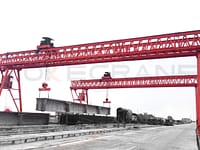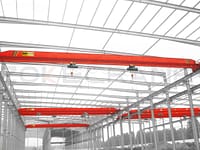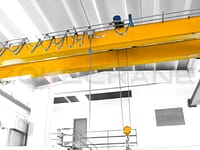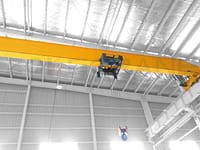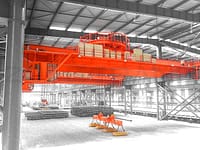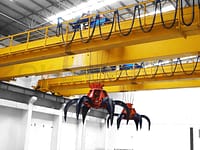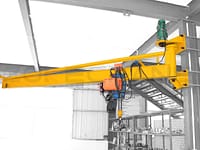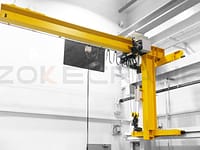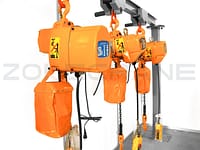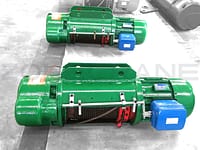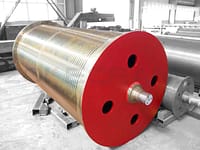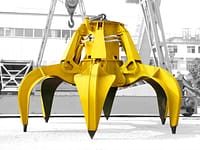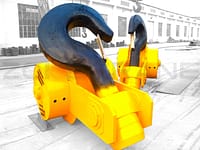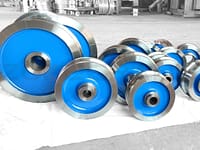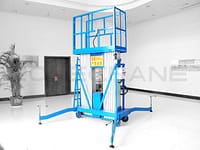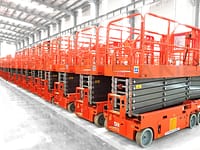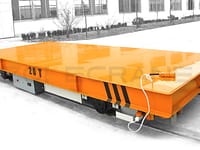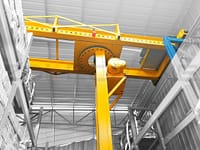This case introduces a small portable gantry crane, which has the advantages of simple structure, easy assembly and disassembly, stable and convenient movement. It is time-saving, labor-saving, safe and reliable to use it for hoisting sleeper plates.
Project Overview
In 2020, we received a Singapore project. The 58 small retarders on the 7th to 36th roads of the construction site need to be changed from hydraulic to pneumatic, and they are required to be completed and put into use within 100 days. The construction tasks undertaken in this section are mainly to dismantle the retarder and the old rails and sleeper slabs within the retarder, remove the old ballast, level the foundation, lay new quart stones to the design elevation and compact it, and replace the new sleeper slabs and new rails. Install in place according to the design position. The key to affecting construction progress and construction safety is the removal and transportation of old sleeper panels and the transfer of new sleeper panels in place. Each retarder is 25m long, and 14 sleeper boards need to be laid. Each sleeper board and its attached electrical equipment weigh about 1.81t.
This is a busy construction site, with more than 9,000 vehicles being assembled daily. The sleeper board is heavy and the construction site is narrow, so it can only be operated on the local road. The replacement of the sleeper board is quite difficult. For this reason, several construction methods that may be used to complete the disassembly and assembly of sleeper plates are analyzed and compared.
Choice of Hoisting Method
1. Manpower hoisting method
A lot of manpower is invested, it is not safe, the construction speed is slow, and it is difficult to complete the project on schedule.
2. Use two rail cranes for lifting
The disadvantages are: (1) The construction of one strand road requires two adjacent strands to be blocked at the same time to park the rail crane; (2) The use of two rail cranes for 100 days requires a large rental fee and increases the construction cost; (3) ) When the two rail cranes enter and exit the strand aisle, they will cause serious interference to transportation; (4) Due to the limited lateral movement of the rail crane, the sleeper plate cannot be directly hoisted from the original position to the flat plate of one of the rail cranes, but only After the sleeper plates are clamped and hoisted, two rail cranes are moved at the same time to send them out of the construction site. However, it is difficult for the two rail cranes to operate synchronously, which is not only low in efficiency, but also difficult to guarantee safety and quality.
2. Self-made small portable gantry crane hoisting construction method
When the sensor is used, the “down” mark of the “up” and “down” mark points on the surface of the sensor should be directed downward and within 350mm from the sleeper surface.
After the ALD is first installed (and after a certain period of use), it should be calibrated. The calibration sequence and method are as follows: (1) First confirm that there is no object between the top surface of the sleeper and the sensor. (2) Measure the monitoring point 2 (TP2) of the control box and adjust the potentiometer R2 to make the voltage measurement value zero. (3) Put a metal plate on the sleeper surface directly below the sensor, and adjust the potentiometer R1 in the control box to make the measured voltage value of monitor 2 (TP2) +10V (at this step, special attention is required. The size and position have a great influence on the measured value. The calibration result must be dynamically checked, and the satisfactory graphics can be obtained in the dynamic state. (4) Remove the metal plate on the sleeper. (5) Adjust the potentiometer R2 on the control box so that the measured voltage at the monitoring point 2 (TP2) is 0.50V.
According to the laboratory test of time drift, temperature drift and sensitive distance and the actual use results on site, the newly developed ALD can fully meet the needs of track inspection.
In consideration of safety, efficiency and practicality, a small portable gantry crane was made to solve the problem of sleeper plate hoisting.
Design requirements:
(1) According to the lifting weight, install a 3kW electric hoist on the top of the small gantry crane. In order to facilitate the sleeper plate in place according to the designed position and facilitate the loading and unloading, the electric hoist is installed on a horizontal traveling device. Due to the heavy load, one electric hoist is used. Manual winch device to make it horizontally move, position and lock. (2) The rail-mounted crane structure is adopted, which has a small self-weight and is easy to disassemble and transfer. (3) The frame structure must ensure that the load travels smoothly and does not invade the boundaries of adjacent lines.
Structure and Performance of Portable Gantry Crane
1. Structural components
GD-2.0 gantry crane adopts rail-mounted crane structure. It is mainly composed of four parts: lifting device, column frame, connecting frame and winch device.
(1) Lifting device: electric hoist, hoist traveling frame, hoisting plate beam, switch box, electrical components,
(2) Column frame: column, connecting steel pipe, running wheel seat, running wheel axle, running wheel.
(3) Connecting frame: center I-beam beam frame. Connecting side frame pulleys, pulley brackets, and pulley seats.
(4) Winch device: ratchet, pawl, ratchet seat, steel wire wheel, crank, steel wire rope, wire rope clamp, unlocking lever, connecting parts.
The electric hoist is the main lifting power, and the winch is used for manual hoisting, and the horizontal movement and positioning lock of the electric hoist are controlled. In addition, manual winches can be used to lift and drop heavy objects when the electric hoist fails. The movement of the small gantry crane adopts four-wheel travel, the traveling wheels are installed on the trapezoidal column frames on both sides, and the small gantry crane is pushed by manpower to complete the linear displacement of the heavy object.
2. Specifications and main technical parameters
(1) Maximum lifting weight: 2t; (2) Maximum lifting height: 2100mm; (3) Effective net width in the main frame: 3400mm; (4) Electric hoist: 1 set of 3kW×2t; (5) Working power supply: three Phase 380V; (6) Travel gauge; 3660mm±10mm; (7) Travel speed <5km/h: (8) Dimensions: 2100mm×2950mm×2900mm.
3. Technical requirements for track installation
(1) Gauge: 3660mm±10mm
Since the electrical ancillary equipment is attached to one end of the sleeper plate, it will inevitably cause the center of gravity to be deviated from the center when it is lifted together with the sleeper plate. Therefore, the construction strand sleeper plate is attached to the side of the existing rail head on the side of the electrical ancillary equipment. As a benchmark, the distance to the inner side of the reference strand rail head of the running track is 1100mm ± 10mm.
(2) Height difference of rail top surface: 350mm±10mm
The height difference between the top surface of the running track rail and the top surface of the construction strand rail is 350mm±10mm.
(3) Traveling rail sleepers
The short sleepers of 500mm length are evenly laid between the two strands, and the sleeper spacing is 3.5m.
(4) Walking track
The track is straight and there are no sharp bends; the joints are high and low, and there are no wrong teeth on the left and right.
Construction Steps for Replacing Sleeper Plates
1. Prepare homework
(1) Lay running tracks on both sides of the construction strand.
(2) The column frame and the connecting frame are connected by bolts; the cables are laid in place and the power is turned on: electric hoist, gourd traveling frame, winch, hanging plate frame and work tools are transported to the construction site; assembling the gantry crane,
(3) Pull the new sleeper board at one time to park near the construction strand.
2. Construction work
(1) At the beginning of the construction of the public works blockade, the old rails of the retarder part should be removed first.
(2) Remove the old sleeper plate: push the portable gantry crane manpower to the sleeper plate to be removed, and the old sleeper plate together with the electrical auxiliary equipment attached to it will be clamped and transported to one end of the construction road and unloaded on the rail car. On the tablet.
(3) After removing the old sleeper plates, remove the dirty ballast, backfill with new guamite, and ram it to the design elevation, level the base surface, and spread the foam board.
(4) Use a portable gantry crane to clamp and transport the new sleeper plates together with the electrical auxiliary equipment attached to it to the laying site one by one, and use the manual winch to make a small amount of lateral movement and position it at the design position.
(5) Level the new sleeper slabs and restore the construction site line.
Implementation Effect
1. GD-2.0 simple small portable gantry crane has a simple structure, most of the components are welded with steel pipe structure, light weight, easy to install and dismantle, and easy to install, disassemble and transfer.
2. The portable gantry crane walks smoothly, conveniently and flexibly. Even if the electric hoist fails during construction, the sleeper plate can be manually lifted and lowered through the winch device. At the same time, it can be moved and locked in a small amount to ensure the sleeper. The board is in place at the design position.
3. The use of small portable gantry cranes for hoisting the rail spoiler saves time, effort, safety and reliability. Each rail spoiler makes a linear displacement of 50m. It only takes about 3 minutes for the old sleeper plate to be lifted to unload on the rail car flatbed, and it takes only about 2 minutes for the new sleeper plate to be lifted from the rail car flatbed to the designed position. No accidents occurred during the entire construction period.
The design of a small portable gantry crane played an important role in the completion of the renewal and overhaul of the small retarder on the Singapore site. It not only shortened the construction period of this project by 35 days, reduced the blockage of 105 shares per day, saved 464 labor, and obtained economic benefits of RMB 1,164,600, but also greatly reduced the interference of construction on transportation.



